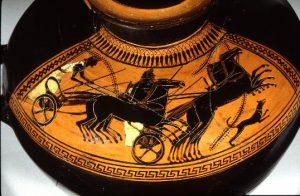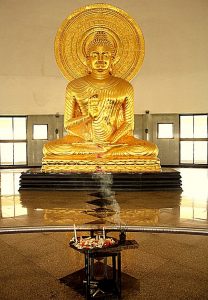As reporters and health officials walked onto the grounds of the mass suicide in Guayana, they were in shock over what they were seeing; hundreds of bodies face down on the ground, dead. One person who was at the site said that the amount of dead bodies was appalling, “it was depicted as not American, not religious, not sane, and ultimately not human.”1 Over 550 bodies of the 900 were unclaimed for almost six months until US Officials decided to cremate them. Once they brought the bodies back to the United States from Guayana, many Americans didn’t think it was right to have these bodies spread out on American soil because of the act they made. US Officials then decided to scatter the ashes of the dead bodies away from the United States border lines.

It all started with Jim Jones. Jones was a religious/political cult leader who had established the People’s Temple as a sect in Indianapolis in the 1950s. His cult focused on themes of communism, and the fight against racism, attracting many African Americans. He moved his cult to San Francisco in 1971, but it would not remain there for long. Soon after the group moved there, Jones was accused of financial fraud, physical abuse of his cult’s members, and mistreatment of children. After Jones was accused, in 1973, he became paranoid that someone would try to destroy his cult, so he moved his entire group to Guayana, South America, to build a socialist utopia known as Jonestown.

Once the cult moved to Guayana, people started to question even more the accusations being made against Jim Jones. Members who had left or escaped the cult were worried for the people still in the cult, so they convinced U.S. Congressmen Leo Ryan of California to fly to Guyana. “In November 1978, Ryan along with a group of journalists and relatives of cult members went to investigate the charges.”2 Jones did not like the idea of people coming to investigate, so he ordered his followers to have Ryan and his investigators assassinated. He ordered the attack on the group as they were returning to the airstrip to leave. A journalist named Charles Krause reported that that morning Ryan was attacked by a man with a knife, although he was not hurt by the incident. “Later that same day, Ryan and his party were attacked by assassins at the Port Kaituma Airstrip. Ryan and four others were killed and ten were injured.”3 While these killings were going on, Jones feared that he would lose his cult members and they would turn against him. He then proceeded to lead his people through a mass suicide, which was something the members had repeatedly practiced since the early 1970s.
These practices were called “White Nights” and consisted of members drinking a liquid that they believed was poisonous as a loyalty test to Jones.4 During these “White Nights,” people were woken up by a loud speaker, and they would assemble for the ritual of passing around a drink of kool-aid, which they were told was poison. Unfortunately, this time was not a test. Hundreds of adults and children lined up to drink this colorful, fruit-flavored punch, which contained cyanide and tranquilizers. Most of them thought they were just proving their loyalty as before, but as more people began to die, they realized that this time it was real. “Over 260 children, for example, had the poison given to them, while only about 40 adults escaped.”5 For those who died willingly though, collective suicide held a religious significance in the context of the worldview that had been established in Jonestown.

Collective suicide was a ritual that signified a purity of commitment to the community. On the night that they all drank this poison, Jim Jones announced “that the members of the community were united as black, proud socialists.”6 Collective suicide also promised release from a world dominated by what Jones perceived as American racism, capitalism, and fascism. He did not want to be captured and taken back to America, so instead he urged his followers to drink the poison, and “step out of the world.”7 Jones had told his followers that they were not committing suicide, but rather they were performing an act of freeing themselves from the harsh world that they lived in. There are later reports that when officials went to Jonestown, Jim Jones was found with gunshot wounds, raising the speculation that either he had committed suicide or someone else had killed him.
The Jonestown Massacre was the largest mass suicide in modern history and resulted in the largest single loss of American civilian life in a non-natural disaster until the September 11 attack in 2001. The mass suicide resulted in over 900 deaths of innocent lives. Once the bodies were found, the Guyanese government asked the United States to take the bodies back. US Officials decided to start sending a few people over to identify bodies so they could decide what to do with them. Over 500 bodies were unclaimed and that is when the United States decided to have the US Air Force come in to take the bodies back to the United States.”8 To this day, families of loved ones are still trying to find a memorial place for the lost lives.
- Encyclopedia of Religion, 2005, s.v. “Jonestown and Peoples Temple,” by David Chidester. ↵
- Dictionary of American History, 2003, s.v. “Jonestown Massacre,” by Carolyn Bronstein. ↵
- Dictionary of American History, 2003, s.v. “Jonestown Massacre,” by Carolyn Bronstein. ↵
- Dictionary of American History, 2003, s.v. “Jonestown Massacre,” by Carolyn Bronstein. ↵
- Encyclopdeia of Religion, 2005, s.v. “Jonestown and Peoples Temple,” by David Chidester. ↵
- Encyclopdeia of Religion, 2005, s.v. “Jonestown and Peoples Temple,” by David Chidester. ↵
- Encyclopdeia of Religion, 2005, s.v. “Jonestown and Peoples Temple,” by David Chidester. ↵
- Encyclopdeia of Religion, 2005, s.v. “Jonestown and Peoples Temple,” by David Chidester. ↵



150 comments
Brianna Ford
This article title grabbed my attention, and as soon as i started reading I was hooked. I am in disbelief that over 900 people committed suicide in Guyana, and all because of a cult leader name Jim Jones. I don’t understand how his following got so big, even when he was accused of abusing some of his followers. What made the people want to stay? What’s most heart breaking is that the fact, till this day, some are still trying to find a memorable place to be laid at peace. This man had crazy amount of power.
Richard Morales
I have heard the phrase “drinking the Kool-aid” before but I never knew where it originated from. Now that I have learned of this horrible massacre I am appalled. How could someone do this to their fellow man. I could not imagine such an evil person, to kill 900 innocent people who you convinced you cared about. It’s interesting to me that the US government sent the air force to retrieve the bodies of the dead cult members. Why was it their responsibility?
Reagan Meuret
This story has come to my attention a few times in the way of people using the expression “don’t drink the Kool-Aid”. However, this article helped clear up all of my questions about it. It is just crazy and sad to see so many lives lost for following the wrong person. I feel as if it can be a lesson to everyone to be careful who you follow and listen to.
Ysenia Rodriguez
Thank you for sharing this unknown massacre with us: it truly was educational. Still, it’s quite astonishing to read that leaders have this kind of power to convince others of mass suicide and killings due to religious beliefs. Jim Jones deceived his followers and had them kill themselves for a religious cause but, in reality, he just never wanted to be caught by the law and sought to keep the attention and loyalty of his followers- a true maniac in my book.
Belia Camarena
It is shocking what happened in Jonestown. The fact that over nine hundred people would commit suicide just because their leader told them to is difficult to comprehend. Jim Jones must have been very charismatic in order to convince so many to blindly follow him. Nonetheless, I do not understand how so many were convinced that something so outrageous was political and socially correct. It is a tragedy how many died that day.
Suvesh Vasal
I had never heard of this tragedy. I am glad I got to read this article and learn something. This article was extremely informative and interesting. However, I could not imagine picking up my life to move and follow some maniac. The White Nights tradition was crazy and appalling. I think Jones had some sort of mental issue. He is responsible for the deaths of all those people in my book.
Anais Del Rio
This was a shocking article to read although I have heard a part of the story before. It was so sad that the people were somewhat deceived with the Kool-Aid thinking it was not harmful since they practiced it many times only for this time to be the real deal. I can somewhat understand why people would want to follow him because he was promising this freedom from the cruel world we live in.
Peter Coons
It still stuns me how a simple, charismatic leader can convince the masses to do unspeakable thinks. Jones had good intentions in the beginning, I’m sure, but he definitely became drunk on power. So drunk, he needed to ensure that he controlled his followers, even unto death. Even today Jones’ influence resides in pop culture with the infamous phrase “Drink the Kool-Aid” when somebody is deeply influenced by a person or idea. The Cults of Personality of the late 1900s are such an intriguing part of history that is not covered as much as I think it should be. This article is a great piece about one such cult.
Austin Pena
Interesting article. I have heard and read about Jonestown in the past but not in the detail that this article provided. it is strange to think that people would follow this man for religious/politcal reasons, but who knows he might have had a way with words. Also i wonder if groups like this continue to exist today around the world, i know of one in Russia but that is about it. I also found it quite strange that the bodies were not disposed of here in the U.S because of the opinion of the people.
Christopher King
Jonestown has always seemed so crazy that anyone would ever follow a guy like that. I have always known the quick story but never the details. The images and footage of the massive amount of death caused by a Jim Jones is appalling. What interested me the most about this article is what happened afterwords with the remains of the dead. The fact that over 500 were unclaimed and many Americans did not want their ashes or any part of them to reside in the borders of the United States.